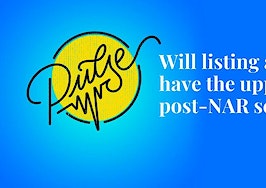It’s a tale of two markets. We are currently seeing fewer sales than at almost any point in history, which normally would signify that we are in the throes of a buyer’s market with prices on a downward slide.
Ironically, in many regions across the country, the opposite is true as the lack of sales is not due to an absence of buyers — it’s because sellers have turned off the spigot resulting in a record low number of available homes to purchase. This has prompted the return of multiple offers with the effect that prices are being pushed higher. It is a weird market for sure.
While the increasing prices are pushing affordability to its extreme limits, there are still plenty of ready and willing buyers in the wings, even with the higher interest rates. This represents a window of opportunity for sellers to reap the benefits of a currently hot market.
As Realtors, the current reality places us in a conundrum: While very conscious of the fact that escalating prices are further alienating a multitude of buyers from the American dream of homeownership, we still have a fiduciary responsibility to our sellers to get the best offers possible.
Assuming that as listing agents our duty is to secure the highest prices possible for our sellers, what is the best way to accomplish that goal?
Before the answer, we need to take a moment to reflect on a bit of history, using the Northern California market as the focus. In our region, real estate practices were fairly stable until the bottom fell out of the market in 2007. As foreclosures began hitting the market en masse in Q4, everything changed.
Up until then, the process of negotiating multiple offers was fairly straightforward: If two or more offers came in, the listing agent typically took the best terms from all of the offers (highest price, shortest contingencies, “AS-IS”, etc.) and crafted them into a multiple offer format that raised the bar for all of the competing offers.
As a buyer’s agent, you could count on all of the terms in the seller’s counter to have been in at least one of the competing offers. Although it took some work on behalf of the listing agent, this practice offered a level of transparency and confidence to buyers. The competing terms were on the table and, if a buyer wanted to sweeten the pot in a subsequent counteroffer, they could do so by submitting a counter of their own.
With the onslaught of REOs, banks took control and changed everything. They dramatically “dumbed down” the offer process, removing the ability for buyer agents to negotiate in good faith. Their logic was simple: “Since we have so many offers to deal with on a daily basis, let’s make it easy.” Their solution? Once all the offers had been submitted, if there was no runaway winner, they countered everyone with, “highest and best.”
This process infuriated buyer’s agents because there was no longer any transparency. Instead of being able to negotiate in good faith, you were forced to guess and write offers in a vacuum. If your “guess” was the highest, great. If not, it was back to the drawing board, and you had to wait approximately 30 days to know how high the winning offer had been.
The fact that many REO listing agents refused to communicate with any degree of transparency made matters even worse, producing significant tension and frustration. Since the majority of homes on the market were REOs, it was either “Play along” or “No house for you.”
With REOs mostly gone by the middle of 2013, you’d think that the “highest and best” practice would have disappeared as well. Unfortunately, some listing agents with normal listings, sensing an “opportunity,” decided to pick up the practice and use it themselves when confronted with more than one offer on their listings. Over time, this has grown to be accepted practice with many agents insisting this is the best way to get the highest possible offers.
I disagree. In my opinion, there are a number of problems with this practice:
It removes the necessity for the listing agent to do their job
With this tactic, listing agents do not need to perform due diligence when providing multiple counteroffers. Instead of taking the time and effort to actually negotiate, they can take a shortcut and simply send multiple counters to all parties that all read exactly the same: “Highest and best.” The worst example of this was a multiple counter I received that stated, “Highest price, best terms.”
It robs the process of transparency
Old school agents used to keep the price of offers tight to their chest and would refuse to provide terms for any number of reasons. Quite frankly, those days are pretty much gone, to the degree that the California-mandated disclosure package includes a statement that offers are not confidential unless the seller states, in writing, their desire to hide the prices and terms. (Rules may vary from state to state.)
Using an auction as an example, there is a high level of transparency because everyone can hear the other bids. In a normal multiple counteroffer situation, details from the other offers are revealed by a proper multiple counter: You can see the highest price and best terms.
In contrast, in a highest and best scenario, no one knows anything. They have no idea if their initial price was the highest or how their terms compare. They are forced to guess and, in many cases, raise their price when they were already the highest offer.
The worst combination of this practice occurs when agents price the property artificially low to garner multiple offers and then use the highest and best tactic to push the numbers as high as possible.
‘Highest and best’ is not an actual counter
A multiple counteroffer, to be legitimate, needs to have terms that can be accepted. If a buyer writes an offer and the seller issues a subsequent multiple counter to a number of offers, buyers should be able, if they accept everything, to sign the seller’s multiple counter and send it back. If more than one counter comes back signed, then the seller can choose which one they wish to accept.
When a counter includes, “highest and best,” it’s not a valid multiple counter because “highest and best” are not actual terms — they are suggestions. Therefore, to legitimize this practice, if the buyer wants the house, they must produce yet another counter with actual terms that can be accepted or rejected by the seller or simply ignore the multiple counter and let their offer stand as written.
In my opinion, “highest and best” practices bring out the worst in agents: Listing agents are shortcutting their responsibilities by refusing to negotiate which in turn produces frustration and even anger in buyer agents who are denied access to the critical information they need to write effective offers.
Additionally, this produces a tremendous amount of reluctance in buyers who, unwilling to throw massive amounts of money into the unknown, tend to respond conservatively when setting offer limits. I have lost count of the number of times buyers, when discovering the final contract price (usually after closing), have stated, “I wish they had told us the price we had to beat — we would have been willing to go higher had they given us an actual number.”
Here is our recommended process for obtaining the highest possible price for sellers:
Start with a comprehensive listing package
In a hot market, the more information you can provide upfront, the better the chances of clean, well-written offers with as few contingencies as possible. Using the San Francisco Bay Area as an example, the package made available to interested buyers includes all mandatory disclosures, pre-emptive inspection reports, a preliminary title report, home warranty (if provided by the seller), HOA package, CCandRs, Natural Hazard Disclosure and any other items mandated by local practices.
We also provide a full list of any upgrades and a FAQ page covering anticipated questions.
Set an offer deadline
As I previously outlined in an Inman post on April 6, 2022,
“We want to build anticipation and competition, so we set a concrete offer deadline (day and time) and state that we will not entertain preemptive offers. Occasionally, I see a listing in the MLS that includes both an offer deadline and a statement that allows offers before the deadline.
This completely nullifies having a deadline and opens the door for a free-for-all.
This not only completely undermines what we are hoping to achieve by setting a deadline, it always leaves the seller guessing about whether they got the highest offer possible.
By law, we are required to show preemptive offers to the sellers if any do come in, but we also counsel them as to the benefits of waiting until the deadline.
Even though we state upfront we will not accept preemptives, we always get buyer’s agents who ask if they can fire in immediate offers. When I explain that I will (i) show their offer to the owner, (ii) counsel the seller to wait and then (iii) use the offer as leverage to get higher offers at the deadline, buyer’s agents choose to wait.”
Actively begin negotiating once offers are in
If we receive more than one offer, we will use the information in each offer to set the initial bar for responses. We do not stop at this point and have the seller choose one offer, even if it appears there is a clear winner. While it is always the seller’s choice to accept any offer at any point in the process, we want to make sure we have performed due diligence and operated in the seller’s best interests by negotiating as best we can.
Rather than send out a demand for “highest and best,” we will begin calling the agents who wrote offers to:
- Let them know the best terms received
- Ask if their buyers are willing to exceed the highest terms in hand
If there is a clear winner in the initial offering, we will not call that agent until we have received responses from the others.
If others come back with numbers and terms that beat the initial highest offer, we then go back to the best offer and give them an opportunity to respond as well. We are fully transparent throughout the entire process by letting all the agents know we are negotiating the best terms for our sellers and that we may contact them a few times before the process is done.
As we do this, we find that:
- Buyer agents are tremendously excited to have a chance to finetune their offers and
- The potential buyers let us know when they have reached their limit by dropping out or standing firm with their current offer
Once we have a winning agreement, we either ask the buyer’s agent to either:
- Submit a revised offer
- Send an addendum with the new terms, or we will issue a counteroffer to the winning buyer with the new terms
You can also do this by issuing multiple counters to the best offers, but it takes a lot longer and, if you have one offer clearly ahead of the rest, it is self-defeating.
Because all the buyers know the exact price and terms they need to beat to win the day, we eliminate the problem of having buyers come back to their agents bemoaning the fact that they would have gone higher had they known the number to beat. While some buyers are reluctant to write appropriate offers at the beginning, the knowledge that other buyers are willing to pay more (in some cases much more) can be the impetus needed to get them writing more effective offers.
There is another plus to this practice as well. When given a “highest and best” counter, buyers never know what the number to beat actually is and therefore will either bow out long before their limits are reached or have a nagging feeling that they unnecessarily paid too much. This last fact can actually ruin their relationship with their buyer’s agent, especially if they felt they were pressured in the process.
Additionally, in this age of litigation with increasing numbers of buyers who believe they were not represented adequately responding by suing their agent, transparency goes a long way in alleviating buyer concerns.
In my opinion, negotiating provides a better solution. If, as an example, five offers come in on a home, only one will win. The other four will move on to the next listing and compete against each other all over again. If “highest and best” practices are used again, they will still have no idea where the bar is and may end up in a circle of frustration as they continue to write meaningless offers.
If, however, they have been given the opportunity to actually negotiate, they know the number to beat the next time and can write more effective offers going forward. Additionally, this also lets them know if they are priced out of a particular market segment so they can readjust and possibly lower their expectations (eg. instead of continuing to look at single-family homes, they can switch to townhouses or condos or look in less expensive neighborhoods).
While I am fully aware that a “highest and best” response is the accepted practice for many agents, in my opinion, it is a shortcut that violates an agent’s fiduciary responsibility, potentially robs the seller of the best price and terms, and alienates buyers in the process. I believe negotiating is a far better solution and, in my mind, separates the mediocre agents from the truly great.
Carl Medford is the CEO of The Medford Team.













